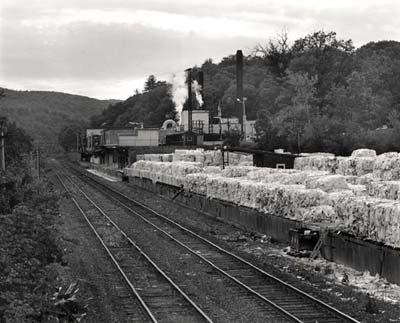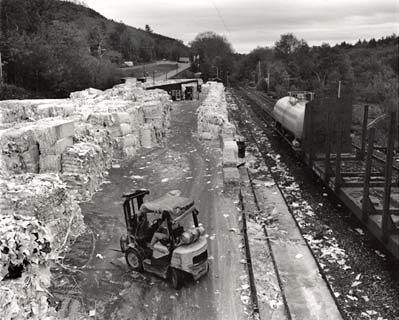Not too far from my home in the mountains of New England there is a road that winds its way through the picturesque scenery. At one point upon turning the corner there is a paper mill nestled down by the river, into an otherwise pristine vista of forested mountains. The steam rises from the stacks day and night. The sight has been one of aesthetic and philosophical contradictions to me as I have driven by for over twenty years now. This industrial landscape, representing so many of the negative connotations of the pollution created by the modern world, happens to be one where recycling occurs. There is a platform just outside the mill that spans over two acres of land. It is covered with bales of bound up paper scraps delivered for recycling. Paper scraps, which the mill purchases from recyclers and will turn into reams of tissue paper. As the winds kick up sending shreds of paper whirling in the air like small cyclones the mill workers hustle throughout the platform driving forklifts. Like busy worker ants they pick through the bales finding the appropriate ones to add to the paper mix, while continually replacing them with newly arrived bales.
The variety of images one can find in these bales by searching through the random placement of paper scraps continues to amaze me on formal and conceptual terms. As I search for visual and communicative breadth in my images, I am constantly viewing these found still life images as a personal contemporary archeological dig, everything which goes on in our society seems to turn up in these bales of discarded waste. It is magical how the juxtaposition of imagery presents individual and cultural voices of the past, whispering, calling out validating both wonderful and sad memories.
The more sensitive we are to the volume and degree of waste we create, the more aware we will be in understanding the product of our society. The sociological evidence emerges from these bales in the form of images creating some commentary on mass culture and mass communication. This excess and scrap is at this plant for recycling, which is positive, but also creates some degree of pollution. Who knows where the balance of positive and negative effects from our prolific use of paper products lies? If this work, which itself is on paper and utilizes chemistry for its creation can ask the viewer to seriously and thoughtfully question their own wastefulness, then it may succeed on more levels then just aesthetic.
John Willis
2001
This work is generously funded in part by the Vermont Arts Council and the Vermont Arts Endowment Fund.
1998 — 2001 7″x7″ Portfolio selectively bleached and toned gelatin silver prints

